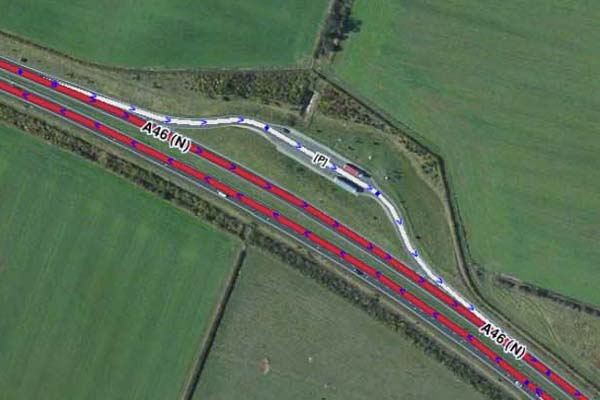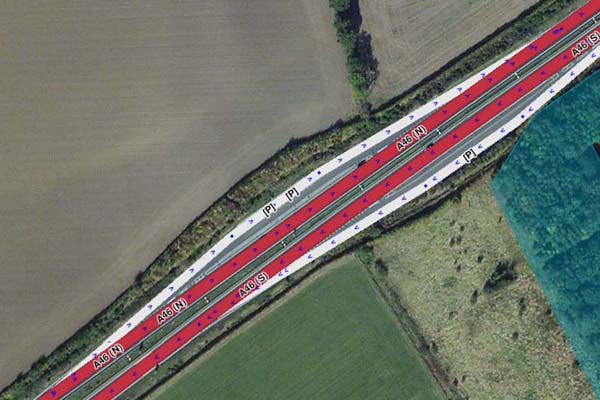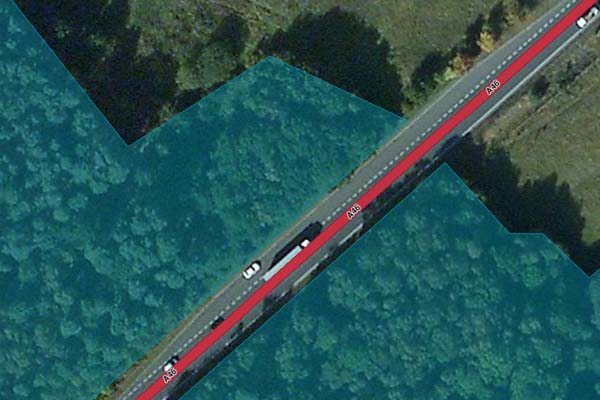Introduction
| This forms part of UK Editing Best Practice. Please read in conjunction with the USA global page on Road types, which has more specific information about each Road type and their characteristics. |
Using the correct Road type and naming of segments is a key part of mapping in Waze. Road type influence route planning, particularly on long journeys where Waze will prioritise the major Road types. The naming of segments give users a consistent experience and can also influence routing and detour mechanisms.
Road types
| Be aware of the WME language setting! This article uses localised names which can be found when using the English (UK) language. |
The following convention should be followed where possible, although it is acknowledged that you may need to deviate from it in some circumstances.
| Waze Road Type | UK Road Types |
|---|---|
| Motorway | All Motorway & Motorway class A roads (locked to L5) M60 A1(M) |
| Major Highway | A-class roads that are classified as Primary Routes (locked to L4) A4600 |
| Minor Highway | Non-primary A-class roads A614 |
| Primary Street | B-class roads and unclassified roads carrying heavier traffic, often seen on Ordnance Survey maps in yellow or orange. B547 |
| Street | Urban Streets, low traffic rural roads |
| Narrow Street | DO NOT USE - This Road type is currently not deemed useful for mapping in the UK (See UK forum discussion ) |
| Private Road | Road with no access for the general public, public roads with legal prohibition on through routing in both directions (private road sign, no motor vehicles except for access sign, or a closable gate). |
| Parking Road | Roads within a car park, or other places where we don't want Waze to monitor speed and potentially generate a traffic jam report, in particular petrol station forecourts. Read more on car park mapping on the UK Car Parks page. |
| Off-road / Not maintained | Unsurfaced road which is often impassable for normal cars and only suitable for 4x4 vehicles. |
Unpaved checkbox - This attribute can be selected for all Road types but should only be applied to Street Road type and below. This checkbox can be applied to segments that cover roads that are unsurfaced or of poor construction but is still passable by a normal car. Users can avoid roads marked with this attribute applied within the App settings. FORDS ***
Non-drivable - Walking Trails are a group of non-drivable Road types available in the WME found under the Road menu. User experience can be improved by using these appropriately, you can read more when to use these Road types on the UK Footpaths page.
Primary Route Network
The primary route network (PRN) designates roads between places of traffic importance across the UK, with the aim of providing easily identifiable routes to access the whole of the country. Primary routes are marked green on most road maps and road signs are green with white and yellow text. The WMEOpenData extension for Firefox and Chrome can overlay this data directly within the editor.
Exceptions
As with any rule, there will be some exceptions. There are two specific scenarios which are allowed to deviate from the OS map:
- A roads that connect between motorway or PRN networks, then it should also be Major Highway
- A section of primary road is restricted to some traffic, and there is another primary route nearby, then it can be demoted to Minor Highway
Exceptions should be discussed on the forum and documented below, and can be locked to a higher level.
| Exception | Reason |
|---|---|
| A1080 London Colney Bypass | Joins A414 to M25 |
| A2, Chatham | The High Street is restricted to buses only. The A2 New Rd to the south is the preferable route. |
| A20, Maidstone | Not PRN - Several bus/taxi only roads adjacent to the A20. |
| A256, Dover | The entire A256 road network south of A2 is not PRN. See Sabre for details. |
| A283, Leatherhead | Link between A24 PRN and motorway junction. |
| A3, Portsmouth | The main "Out of City" route is signposted North along Hope Street. |
| B306, Roehampton | Turning right from A205 to A306 is only possible via this small loop of B road. |
| A3216, Battersea | Shown as PRN in the OS data, but not signed as a primary route in Streetview imagery. Would benefit from site visit to confirm current status. |
| A4146/A509 Milton Keynes | Joins A5 (PRN) to A421 (PRN) to M1 |
| A43, Corby/Kettering | New road, compliments the now renamed A4300. Road signs are green, OS zoom7 shows both old and new roads as PRN. |
| A46, Grimsby | Link End of A46 shown by OS as PRN with A16 as Major Highway. These roads are signed as green. |
| A460, Cannock | Newer A460 replaces older A4601 |
| A527, Newcastle Under Lyme | This is not part of the PRN anymore since the link road was built to the A500 at the junction of Grange Ln and Church Ln. |
| A56, Bury | Joins the PRN between A56 and A58. |
| A577, Atherton | Eastern and southern section passes through a pedestrianised zone. Bag Ln at the western end is signposted as PRN and needed to complete the route eastbound and westbound. |
| A58, Bury | Joins the PRN turning right from A58 to A56. |
| A6, Loughborough | The central area of Loughborough has been pedestrianised and the A6 has been diverted along an upgraded relief road. |
| A6097, Newton (Notts) | The spur of the A6097 is not shown as PRN but roads are green on signs, the link roads going to/from A46 (S) Ramps have also been set as major highway to ensure a continuous route (these were formerly the A46). Note: The Aerials and Street-view here are significantly out of date following the upgrading of the A46 to Dual carriageway, the current layout was checked with a physical site survey. |
| A614, Howden | OS Map doesn't connect the primary route to the motorway, leaving a gap that could affect routing. |
| A617, Mansfield | A617 is shown as Primary in some sources, and does have green signs |
| A664, Manchester | Streetview of Rochdale Rd shows it has white signs, so it is not PRN. |
| A665, Manchester | Recent roadworks have made A665 - Miller St one way, so it makes sense to promote the other way. |
Dual Carriageways
The following convention should be followed where possible, although it is acknowledged that you may need to deviate from it in some circumstances.
When to Split
A road should be split into be 2 one-way roads if any of the following conditions are met:
- The central reservation is > 5m
- There's a visible gap between average of all GPS traces
- It is split by physical barrier (Concrete, Armco, pedestrian barrier etc)
Pedestrian refuges and painted road separation (cross hatching that can be driven over) should not normally be split. Be aware there are a lot of these that were created as split roads during the UK Base-map import, these usually need merging to be a single two-way road.
Naming Convention
Whenever possible, on split roads, name carriageways with the direction of travel. Insert the direction of travel at the end of the road name:
Examples: 1. M1 (N) 2. A4 (W) 3. M25 (ACW) 4. A57(M) (W)
This makes traffic and incident reports much more useful and helps with navigation.
For Freeways leave the City Name as "None", so as to stop the City Names smearing. For Motorway class A roads, name as Axx(M). (No spaces).
Ramps (to/from Motorways and Dual Carriageways)
Where should I start the sliproad?
For best navigation and routing advice, sliproads leading:
off a Motorway or Dual Carriageway should be placed to start where
- The lane begins to divide (in the case of 3/2/1 markers)
- There is a gantry over the carriageway, where the 1 mile, 1/2 mile etc finishes. This will usually be the last gantry before the actual junction and will be the one without a distance marker on it
on to a Motorway or Dual Carriageway should be placed where
- the road first joins the adjoining road, i.e. just after the chevrons/lane dividers
Ramp naming
Ramp names to be short, useful and unambiguous. Names should not include Junction to nor Entry to. Cardinal directions (N, S, E, W) should only be included if they are included on signs and provide clarity. Like other abbreviations, the > character can be used, and is read out as towards, this should be used only if needed. Entry and Exit should be considered equal for the purposes of naming, and should be named to give the most useful instruction to the driver. Ramps should not have a City name, this helps prevent city smudge.
Junctions with numbers
- All segments from numbered junctions should be mapped as Ramps to ensure exit instructions are given
- The name should begin with the exit number and then the name of the road it leads to, ideally without cardinal directions
- When motorways split, short wayfinder ramps should be used so that these names don't appear in the App
- Do not include junction numbers on entry ramps.
- Format:
J[number] to [simple road name]- Example:
J4 to A464
Junctions without numbers
- If a ramp connects directly to exactly 1 other road, then it can be left unnamed, the instructions will naturally take on the name of the next segment
- It may be desirable to name the ramps more simply to remove cardinals or road names
- If the ramp connects to a roundabout, then an unnamed segment will often give optimal instructions. If the routes away form the roundabout are not signed from the main road the ramp should be named to match the exit signs.
- Format:
[simple road name]- Example:
A1rather thanA1(M) (N)orA1 - Great North Road
Disambiguation
- Where a ramp forks into two directions, then the ramp names should include cardinals (if signed) or towards a city based on the signage
- If a city name is used only one city from the directional sign is to be used, preferably the one which is listed first
- On the M25, where relevant, directions to Heathrow or Gatwick should take precedence
- If the section of ramp before a fork is particularly short, then the preceding segment can be left unnamed with any junction number written in the forked segments
- This does result in longer announcements, so should be avoided if possible
- Where both directions of a road are connected to a roundabout, then ramps can be disambiguated using > city instead of cardinals, as per the signage.
- Format:
[simple road name] ([cardinal direction])[simple road name] > [city name]Junction > [city name]if connecting road has no name / number- Example:
A1 (N)&A1 (S)M62 > Manchester&M62 > Hull
Junction Naming
Major junctions, particularly on motorways, should be labelled with a landmark.
Under no circumstances should the road name or city name fields of a segment be used for naming of a junction.
Road Name & Number
Where a road exhibits both a road number and name the following convention should be used:
<Number> - <Name>
Examples: 1. A7 - Old Dalkeith Rd 2. A1 - Edinburgh Rd
This gives both a consistent appearance and allows a straightforward transfer if/when Waze UK moves to the official Department for Transport designations.
The same can also be said for adding the direction of travel on single/dual carriageways with an A-road designation in the form
<Number> (Direction) - <Name>
Examples: 1. A2 (W) - Dover Rd 2. A229 (N) - Cuxton Rd
Abbreviations
Due to the size of most devices it is advantageous to keep on screen text to a minimum. When naming segments the following abbreviations should be used to conserve space. Each will be expanded by the Text-To-Speech (TTS) engine and voice instructions will read aloud the full word, Ave will be read as Avenue, etc.
When naming a segment the first word word in the name should never be abbreviated, nor should names that only include single words (excluding The). Green Street should be written as Green St and The Boulevard be written in full. Multiple abbreviations in the same segment name can be used where appropriate, Aston Boulevard West can be written as Aston Blvd W.
|
Notes:
- Should you require TTS to read a letter, such as Car Park E, place a period (.) directly after the letter.
- J, used for road junction numbers, is the only abbreviation that can lead a segment name.
- The period (.) in the abbreviation of Saint is important otherwise it will be read as Street.
Roundabouts
Roundabout segments should typically remain unnamed. If the roundabout does have a proper, signposted name, then this can be labelled using a landmark of "Junction/Intersection" type that fills the centre of the roundabout. This only applies to big roundabouts that are larger than 30 metres.
For further advice on editing roundabouts, see Editing Junctions and Roundabouts
Lay-bys
- Lay-bys should only be included where there is significant separation from the main road (e.g. grass, trees or a physical barrier) in a similar way to deciding if a road is dual carriageway.
- Routes in and out should be mapped with roads of "Parking Lot Road" type, with appropriate directions and turns.
- The Lay-by road should have no city name and the road name set to "[P]".
- A Landmark is not required for lay-bys.
Lay-by Examples:
This example shows significant separation between the road and Lay-by:

This example is only separated by the distance between the (N) and (S) carriageways which is the minimum that you should map. Note that the "parking lot road" is mapped over the area that vehicles park on to improve separation:

This example does not have enough separation for the Lay-by to be mapped:

(Note: this example is zoomed in closer that the previous two!)
Bypass or By-pass?
Bypass.
Railways
Railway lines should be drawn in as Railroad type roads, particularly if there are other streets nearby. They appear in the client, and they keep Wazers on trains from polluting the local speed data.
Tracks should be drawn as simply as possible - they do not need to be accurate out in the country where no one can see them, and it is not necessary to map individual tracks through a station.
Segment Properties:
- City: No City
- Name: No Name
- Type: Railroad
- Direction: Two way
- Level: Ground, unless actually going under or over over another road
- Lock: 3
Railroad segments can be connected to the road network at level crossings, without any risk of Waze routing drivers onto the tracks. The extra granularity of segments at the crossing provides more accurate routing information. All turns should be enabled (no red arrows please).
Check that:
- "old" roads, with addresses along them, are broken by segment nodes each side of a railway bridge. This enables Waze to navigate to addresses adjacent to the bridge when Network Rail close the road for engineering works.
- "new" roads, with no addresses along them, are not broken at railway bridges, since such roads are always closed junction to junction, and intermediate nodes are a nuisance (sometimes necessary for speed limit changes, but not for bridges).
Railways which are underground (i.e. through tunnels) must not be mapped.
For more detailed information on railways, please see the Road_types/USA#Railroad but be aware that the guidelines written above take precedence.
Note: it is often necessary to split railways lines at county boundaries to avoid smudging the county name into the wrong area.
« Back to UK Editing Best Practice